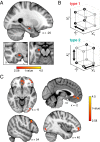Dynamic updating of hippocampal object representations reflects new conceptual knowledge
- PMID: 27803320
- PMCID: PMC5135299
- DOI: 10.1073/pnas.1614048113
Dynamic updating of hippocampal object representations reflects new conceptual knowledge
Abstract
Concepts organize the relationship among individual stimuli or events by highlighting shared features. Often, new goals require updating conceptual knowledge to reflect relationships based on different goal-relevant features. Here, our aim is to determine how hippocampal (HPC) object representations are organized and updated to reflect changing conceptual knowledge. Participants learned two classification tasks in which successful learning required attention to different stimulus features, thus providing a means to index how representations of individual stimuli are reorganized according to changing task goals. We used a computational learning model to capture how people attended to goal-relevant features and organized object representations based on those features during learning. Using representational similarity analyses of functional magnetic resonance imaging data, we demonstrate that neural representations in left anterior HPC correspond with model predictions of concept organization. Moreover, we show that during early learning, when concept updating is most consequential, HPC is functionally coupled with prefrontal regions. Based on these findings, we propose that when task goals change, object representations in HPC can be organized in new ways, resulting in updated concepts that highlight the features most critical to the new goal.
Keywords: attention; category learning; computational modeling; fMRI; hippocampus.
Conflict of interest statement
The authors declare no conflict of interest.
Figures




References
-
- Love BC, Medin DL, Gureckis TM. SUSTAIN: A network model of category learning. Psychol Rev. 2004;111(2):309–332. - PubMed
-
- Kruschke JK. ALCOVE: An exemplar-based connectionist model of category learning. Psychol Rev. 1992;99(1):22–44. - PubMed
-
- Goldstone RL. Perceptual learning. Annu Rev Psychol. 1998;49:585–612. - PubMed
-
- Knowlton BJ, Squire LR. The learning of categories: Parallel brain systems for item memory and category knowledge. Science. 1993;262(5140):1747–1749. - PubMed
Publication types
MeSH terms
Grants and funding
LinkOut - more resources
Full Text Sources
Other Literature Sources

